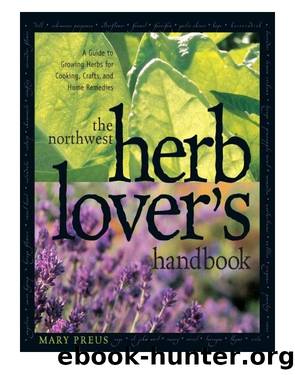The Northwest Herb Lover's Handbook by Mary Preus

Author:Mary Preus
Language: eng
Format: epub
Publisher: Sasquatch Books
Published: 2011-05-16T00:00:00+00:00
â Elder
Common names: Elder, Elderberry
Latin name:
Coast red elderberry: S. callicarpa (or S. racemosa callicarpa), and others
Blue elderberry: Sambucus caerulea
American elderberry or North American sweet elder: S. canadensis
Black elderberry: S. melanocarpa
Related species: European elder, S. nigra
Varieties: âMadonna,â âYellow Variegated,â âGuincho Purpleâ, âJohns,â âYorkâ
Latin and common family names: Caprifoliaceae (Honeysuckle family)
Description: Elder has a long, long history as a culinary, medicinal, and cosmetic herb and a reputation as a powerful, even magical plant. Although the folklore surrounding it usually refers to the European elder (S. nigra), many of the species native to the Northwest have similar attributes and uses.
The blue elderberry, S. caerulea, grows wild throughout the region in all except the coldest climatic zones. It is a deciduous perennial shrub, usually 10 to 20 feet tall but sometimes growing up to 40 feet, depending on conditions. Leaves are large, graceful, and similar in shape to walnut leaves. They are opposite, 6 to 9 inches long, each having five to nine pointed leaflets with serrated edges; the stems are hollow. In June or July, the plant is covered with a froth of tiny, star-shaped blossoms in flat-topped clusters (cymes) which the sixteenth-century herbalist Gerard described as âspoky rundles.â These ripen in September or October into hanging bunches of round, purple, juicy berrylike fruits dusted with a waxy white substance that gives them a powder blue appearance. The three to five stones inside the berries each contain one seed. The black elderberry (S. melanocarpa) is the variety most common east of the Cascades; it is generally shrubby to 6 feet, with shiny black berries. The coast red elderberry, S. callicarpa, has small, pyramidal flower clusters that appear in late spring. Its bright red berries ripen in midsummer.
Named fruiting hybrids of American elderberry (S. canadensis) include âYorkâ and âJohns,â which have sweet, large, tasty berries and form compact ornamental shrubs 6 to 10 feet tall. Two canadensis varieties are required for pollination.
Planting information and cultural directions: Elder trees are often seen growing wild by the roadside, especially at the outer edge of the woods, along ravines, or near streams and other moist places. They adapt well to any situation with partial shade and a moderately rich, well-drained soil. Starts dug from the wild or cultivars from a nursery are best planted in early spring or late fall.
Propagation: Patience is required for starting elder from seed, and germination can be erratic. Collect ripe fruit in autumn and mash it in a bowl. Fill the bowl with water and separate the seeds, which float, from the pulp. Rinse the seeds and drain them in a sieve. Make a special nursery bed and mark out rows about 1 inch deep and 6 inches apart. Sow seeds about 2 inches apart and fill in the furrow with compost. Mark the location carefully, since germination may take more than a year. Elder is more often propagated by taking 12-inch-long hardwood cuttings in late autumn (see Chapter 1), which can be planted out about one year later. It may also be possible to dig suckers that sprout from the treeâs roots.
Download
This site does not store any files on its server. We only index and link to content provided by other sites. Please contact the content providers to delete copyright contents if any and email us, we'll remove relevant links or contents immediately.
Turbulence by E. J. Noyes(7936)
The Thirst by Nesbo Jo(6826)
Gerald's Game by Stephen King(4582)
Be in a Treehouse by Pete Nelson(3946)
Marijuana Grower's Handbook by Ed Rosenthal(3622)
The Sprouting Book by Ann Wigmore(3543)
The Red Files by Lee Winter(3368)
The Remains of the Day by Kazuo Ishiguro(3293)
Sharp Objects: A Novel by Gillian Flynn(2956)
Christian (The Protectors Book 1) by L. Ann Marie(2654)
Organic Mushroom Farming and Mycoremediation by Tradd Cotter(2626)
The Culinary Herbal by Susan Belsinger(2431)
Stone Building by Kevin Gardner(2349)
The Starter Garden Handbook by Alice Mary Alvrez(2282)
Lilac Girls by Martha Hall Kelly(2258)
The Unlikely Pilgrimage of Harold Fry by Rachel Joyce(2219)
The Lean Farm Guide to Growing Vegetables: More In-Depth Lean Techniques for Efficient Organic Production by Ben Hartman(2096)
Urban Farming by Thomas Fox(2061)
Backyard Woodland by Josh VanBrakle(1895)
